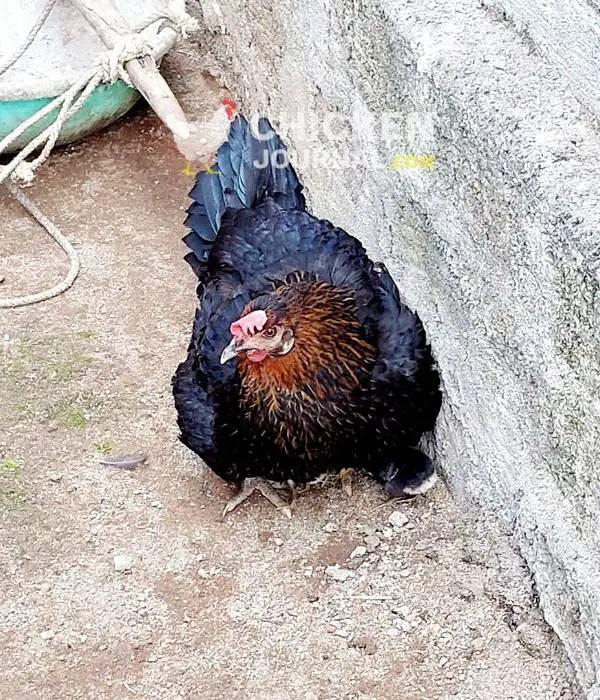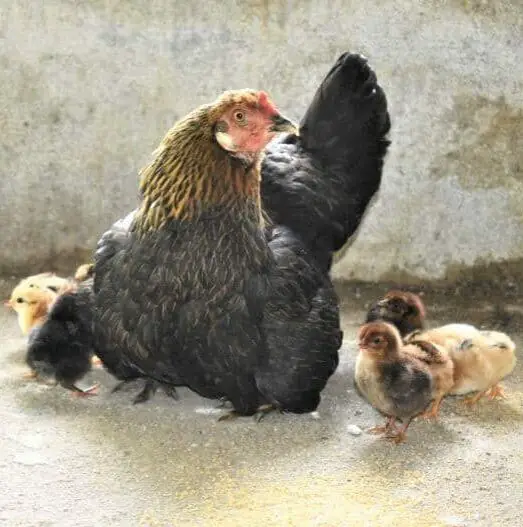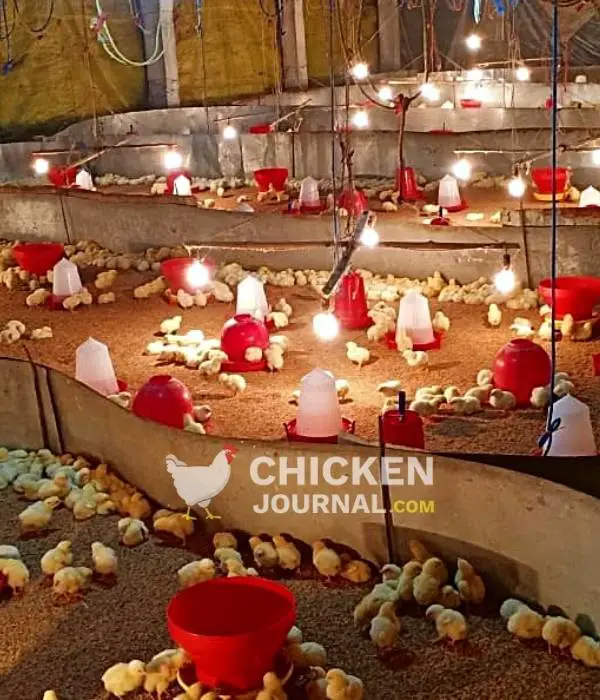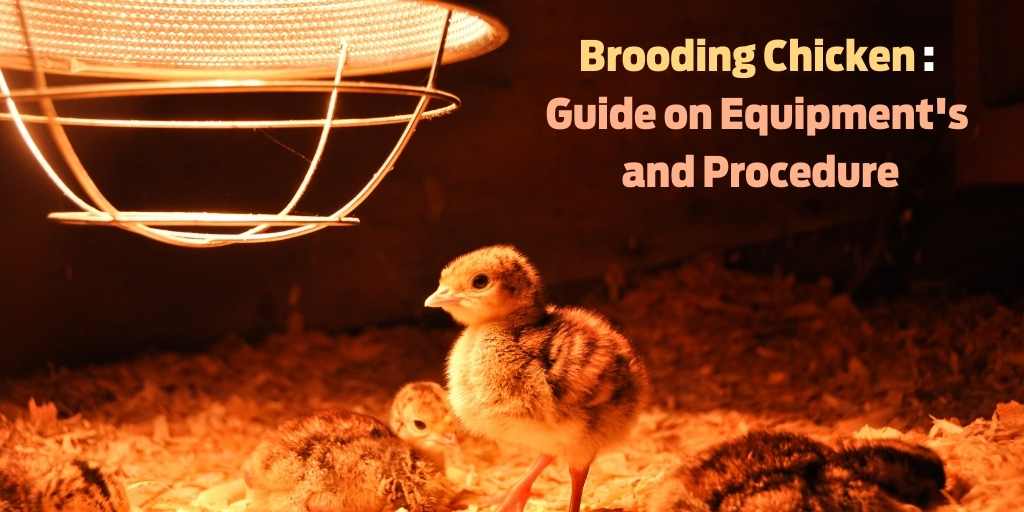Do you want to know all about brooding chicken? It is a significant thing to know if you are raising baby chicks.
Brooding is right after a chick hatches when it needs extra care and warmth to control its body temperature. This time is critical for your baby chicks to grow well.
That is why every chicken raiser must know all about brooding chickens.
This definitive guide on brooding chickens will include:
- The meaning of brooding chickens in poultry.
- Its significance in poultry farming.
- Natural vs. Artificial Brooding.
- Space requirements for brooding.
- Types of brooders with how-to-use guide.
- Temperature for brooding chicks.
What is Brooding Chicken in Poultry?

Brooding chickens is crucial for baby chicks. All newly hatched chicks require food, water, and warmth. Warm temperature is given by artificial brooders or naturally.
The brooding process lasts 5–6 weeks until the newborn chicks can regulate their body temperature. You can see feathers covering their body after this brooding period.
Baby chicks depend on their mother hen during brooding for heat and security. They also learn self-care and foraging from their mother hen.
What matters is giving the chicks the right brooding space, nutrition, and caring. Brooding chickens requires keeping the chicks warm.
Understanding chicken brooding makes it a little easier for poultry farmers. Baby chicks are artificially brooded if the mother hen is absent.
Also read: 29 Best Broody Chicken Breeds
Importance of Brooding Chicken
Chicks need brooding to survive and develop. They grow, develop feathers, and learn self-care at the brooding stage.
Without brooding, chicks suffer colds, malnutrition, and predator attacks. Brooding helps chicks grow their immune systems.
Mishandling brooding can cause several problems. Potential health issues in newborn chicks include poor growth and susceptibility to infections.
In poor weather, chick mortality might be high. Brooding greatly affects the success of your poultry company. Understanding how to do things correctly is important.
Brooding Chicks Inside vs. Outside: Pros and Cons
Common advantages and disadvantages of brooding chicks, both indoors and outdoors:
Brooding Chicks Indoor
Advantages of Brooding Chicks Inside
Indoor brooding promotes chick growth. You can control the inside environment better.
Temperature and humidity may be more effectively controlled indoors to keep chicks comfortable and warm.
Appropriate control of temperature plays an important role for chicks in their first few weeks when they are most susceptible to variations in temperature.
Furthermore, indoor brooding protects chicks from outside predators. So, they live safely, protected against rats, birds of prey, and other pets.
This safeguard lets them develop without worry or bullying, encouraging better development.
Disadvantages of Brooding Chicks Inside
Inside brooding has a few disadvantages. The main limitation is space.
With a lot of chicks, small indoor brooding settings might become overcrowded. Chicks can become stressed, sick, and aggressive due to congestion.
When brooding chickens indoors, cleanliness is important. Regular cleaning and sanitation are necessary to maintain the health of chicks in confined spaces due to the increased risk of disease transmission.
In addition, closed indoor spaces might inhibit chicks’ normal activities. They may be unable to wander around and scratch at the ground as freely as outdoors.
Brooding Chicks Outdoor
Advantages of Brooding Chicks Outside
However, outside brooding has advantages. Chicks may scratch, and dust bathes more freely.
Sunlight provides vitamins and regulates circadian rhythms, boosting development and health.
Early outdoor brooding helps baby chicks adjust to their external environment, allowing them to learn more about outside foraging.
Disadvantages of Brooding Chicks Outside
Outdoor chicken brooding also has a few problems. Both humidity and temperature regulation may be difficult in extreme weather areas.
Temperature changes and bad weather can stress and harm chicks. Outdoor brooding exposes chicks to predators like birds of prey, raccoons, snakes, and stray dogs, which is a major concern.
Outside exposure exposes chicks to harmful parasites like mites, fleas, lice, and ticks. Which mostly causes health issues in poultry birds.
Also read: How to Take Care of a Broody Hen in Winter?
The Natural Brooding By Hen

The natural brooding process in hens is amazing. Mother hens protect and raise their baby chicks from hatching. This natural brooding process helps chicks survive and grow.
After egg hatching, the mother hen becomes quite aware. She gently nudges the chick with her beak upon hatching to encourage movement and strength.
Then, the mother hen gathers them beneath her warm body. She extends her wings to protect and comfort them.
Chicks need the hen’s body warmth to develop correctly since they can’t regulate their body temperature. The mother hen also transfers antibodies from her body to her chicks, improving their immune systems and protecting them from sickness.
The mother hen teaches her baby chicks what to eat and where how to find it with gentle pecks and vocalizations. She also trains them how to live safely away from predators.
As they get older, she takes them on exploring farms and backyards and teaches them to dig for insects, grass, and seeds. She helps the flock communicate by clucking and other sounds.
The mother hen provides brooding beyond protection and education. Her chicks receive emotional support, too.
The mother and her baby chick’s regular interactions show their deep attachment. Mother hens cooing and chirping to calm their young. This makes the chicks feel protected and loved, improving their mental health.
After a few weeks of natural brooding, the chicks become independent and leave their mother. The hen and her young remain close throughout their lives, relying on each other for friendship and security.
Remember that not all chickens get broody after laying eggs. Ancona, Andalusian, Barred Rock, Croad Langshan, Barnevelder, Campine, and other chickens rarely go broody. They do not like to sit on their eggs.
To hatch their eggs and raise chicks, you may require an incubator. Heating for brooding hens is essential at the most crucial stage when the chicks need warmth and care.
Complete Process of Brooding Chickens (Using Heaters)
1. Brooding House Setup Before Arriving of Baby Chicks
Your brooding house must be ready before baby chicks arrive. Building a brooding coop starts with finding an appropriate spot.
a) Chicken Brooding House Location
The most crucial question when creating a chicken brooding house is location. Keep the brooding house isolated from other chicken coops to protect your newborn chicks from infections.
A chick brooder house must be 100–200 meters from the chicken farm. Baby chicks require a clean, safe, and sterile room to avoid external illnesses.
Better to design a closed chamber for newborn chickens. Add excellent exhaust fans to your chicken coop for ventilation.
Closed coops keep the brooding house warm and prevent external illnesses. Keep baby chicks in separate farms and use boots, masks, and gloves when entering inside.
b) Brooding House Preparation
The chicken’s brooding house must be ready before the chicks arrive. Before baby chicks arrive from the hatchery, remember these key tips:
Prepare your chicken brooding home a week before the chicks arrive.
Before a week, clean the brooder.
Remove and clean old batches of chick poop and litter from that brooding coop.
Properly clean the brooding house floor and walls. Sterilize brooding equipment with disinfectant.
Sterilization requires high formaldehyde gas concentration. You will get it from your local chemical or veterinary medicine store.
After 24–48 hours of airtightness, let the room dry up after formaldehyde usage. Use the ventilation fan to expel gas outdoors.
In the brooding coop, disinfect a 3-meter cube with 35 cc Formalin and 17.5 grams of potassium permanganate.
2. Brooder Guard Setup Inside Brooding Coop
The brooder guard is a small temporary wall that keeps baby chicks in a small area. It helps farmers by providing them with heat in a specific place.
It helps in preventing the chilling and pilling of newly hatched chicks. Always ensure that your brooder guard is sturdy, properly sterilized, and built with good-quality plastic.
It keeps your chicks in a particular area to stay near the heat source. The height of a brooder guard must be between 16 and 18 inches, or else the chicks will jump out. It will also save them from the wind and cold.
Brooding is done inside the brooder guard. Until the chicks’ feathers grew enough, they were kept inside this brooder guard, and the heat was given using various equipment.
Use paper above the floor bedding for the first three days and spread chicken pre-starter feed above it. After three days, remove the paper from the floor bedding and use the deep litter system.
You can use paddy husk, wood shavings, ground maize cob, chopped straw, sawdust, and groundnut shell for a deep litter system. Keep the height of the bedding to about 6 to 9 cm in the winter and 3 to 4 cm in the summer.
3. Receiving Baby Chicks
When the baby chicks reach your chicken farm, you need to read a few things:
- Turning on the heater or lamps before the baby chicks arrive at your chicken farm is a good idea. This makes the environment warm.
- Check the condition of the baby chicks to see whether they are healthy.
- After checking, keep them inside your brooder guard as soon as possible.
- Use at least one 12 kg capacity feeder and one 3 liter capacity drinker for every 100 chicks inside the brooding area or brooder guard.
- You can add a few electrolytes and probiotics if chicks are looking dehydrated.
4. Types of Brooders for Brooding Chicks

Today, many types of chicken brooding equipment are available in the market. Some are traditional, and some are advanced tools.
- Infrared bulb and reflector brooder.
- Heating plate brooder.
- Hover brooder or brooder boxes.
- Forced air heater for brooding.
- Traditional infrared gas brooder.
a) Infrared bulb and reflector brooder for chicks
- BULBMASTER - This R40 Red Reflector is a 250 Watts, 120...
- RED HEAT LAMP- Used In Recessed light fixtures in...
- RED BROODER BULB- This lamp Provides Radiant Heat that...
- BEAUTY SALON -Perfect replacement for Sauna, can also...
- LONG LIFE - This R40 Heat lamp has a lifespan of 6000...
Last update on 2025-10-03 / Affiliate links / Images from Amazon Product Advertising API
- Multifunction: can be used as a table lamp in your...
- Material: 8.5inch aluminum reflector, 150W max phenolic...
- Function: the clip is firm and well fixed, 360°...
- Specifications: 8.5X4.25X10 inch, rated for up to a...
- Package include: 2-pack 150W 8.5inch aluminum reflector...
Last update on 2025-10-03 / Affiliate links / Images from Amazon Product Advertising API
Infrared bulbs or light brooders with reflectors are used for brooding baby chicks. It uses an infrared bulb and a reflector to distribute heat uniformly.
This brooder warms chicks by providing a continuous and localized heat source. The mechanism of operation is simple.
The infrared bulb heats up when power goes through it. The reflector helps to focus the heat downward, providing a warm spot for the chicks. Raising or lowering the bulb height controls the temperature in this type of brooder.
The number of chicks and brooder size determine the capacity of an infrared bulb brooder with a reflector. A six-lamp brooder is ideal for 500 chicks.
However, you must always ensure that chicks remain comfortable and control the brooder to maintain the proper temperature.
Infrared bulb brooders are widespread; however, they have drawbacks. If not correctly monitored or installed, they can cause fires.
b) Heating plate brooder for chickens
- BROODER HEATER CHICK HEAT PLATE: Thermo-Poultry Chicken...
- ADJUSTABLE HEAT PLATE: Brooder plate for chicks...
- DURABLE & EASY TO CLEAN - Made with sturdy,...
- SAFETY LISTED: K&H products are safety certified,...
- SIZING: Small brooder heater measures 8” X 13.5” X...
Last update on 2025-10-03 / Affiliate links / Images from Amazon Product Advertising API
Baby chicks can be heated with a plate brooder instead of heat lamps. It simulates the mother hen’s warmth with a rectangular device with adjustable legs.
The chicks replicate their natural behavior with a hen by pressing their backs against the plate to maintain body temperature.
Heated plate brooders are safer and more energy-efficient than heat lamps. Heat plates warm solid items with safe radiant heat from the underside.
This allows the young to regulate their own body temperature by choosing when they need more heat and when they don’t. In comparison, heat lamps can cause fires and other safety problems and don’t spread heat evenly.
A heated plate brooder provides localized and steady warmth for chicks by producing radiant heat. You can adjust the plate’s height as the chicks develop to ensure they feel comfortable at various stages of growth.
The size and number of baby chicks determine a heated plate brooder’s capability. Choose a brooder plate with movable legs to support chick growth.
c) Hover brooder or brooder boxes
- Adjustable light, transparent board for you to observe...
- Brooder box uses odor-free materials, and has two holes...
- Warms up to 15-20 chicks. The material of the brooder...
- House structure makes insulation effect better, keeping...
- Contains: a brooding box, 2 heating lamp, and 1 bulb...
Last update on 2025-10-03 / Affiliate links / Images from Amazon Product Advertising API
A hover brooder, also known as a brooder box, is a form of brooder that provides warmth and a controlled environment for baby chicks.
It is a covered container with a heating element mounted to the top. Hover brooders replicate a mother hen’s warmth, making chicks feel safe and comfortable.
The working mechanism is simple but effective. Hover brooder heating elements produce a warm, contained atmosphere inside the box.
The chicks can cluster under its warm hovering like a mother bird. The chicks can cluster together in the hover brooder and feel safe, which adds to their sense of security.
Hover brooder capacity depends on size. Smaller brooder boxes hold 20-30 chicks, whereas larger ones hold 100+. Space is crucial for chicks to roam around and get food and water.
The hover brooder has many advantages over other brooders. They prevent heat light mishaps and fires by providing a controlled environment.
All chicks receive consistent warmth from their uniform and localized heat source. The enclosed chamber keeps heat in hover brooders, making them more energy-efficient.
Hover brooders require regular temperature monitoring and adjustments. The first week, newborn chicks should be around 95-100°F (35-38°C).
Lower the temperature by a few degrees per week until the chicks are fully feathered and can regulate their body temperature.
Hover brooders are reliable and effective at warming and protecting newborn chicks. They mirror the natural habitat and help chicks develop stress-free and healthily.
d) Forced air heater for brooding
- 80,000 BTU
- Heats up to 1,900 square fee
- Comfort Control Thermostat allows more control and...
- Exclusive run time Fuel Gauge
Last update on 2025-10-03 / Affiliate links / Images from Amazon Product Advertising API
A forced air brooder uses a heating element and fan to circulate warm air evenly across the brooding room and chicken coop. This brooding method has advantages over heat lamps.
First, forced air heaters distribute heat more evenly, reducing hot or cold areas in the brooding area. This gives chicks a safe and comfortable environment, boosting healthy growth and lowering stress.
Second, forced air heaters use less energy than heat lamps. The fan distributes warm air throughout the brooding area and chicken coop. This improves heat retention and reduces heat loss, saving energy.
A forced air heater generates heat with an electric coil. The fan circulates the heating element’s warm air throughout the brooding area or coop to maintain a steady temperature.
The size and features of a forced air heater determine its brooding capacity. These warmers usually hold many newborn chicks.
The heater’s model and design determine its capacity, which can be several dozen to several hundred chicks. It is available in working with electricity, propane, and kerosene.
e) Traditional infrared gas brooder
Last update on 2025-10-03 / Affiliate links / Images from Amazon Product Advertising API
The infrared gas brooder is a variety of artificially brooding equipment for brooding chicks. Chicks are warm and controlled in this specially built environment.
This brooder uses infrared heat from a natural gas or methane heating element. The brooder is usually kept 3–5 feet above the chicken coop or pen floor.
Heat distribution is efficient and effective with an infrared gas brooder. The brooder’s infrared heat promotes healthy growth and reduces temperature differences between regions.
The heating element attached to the gas supply generates heat. The chicks and environment are warmed by infrared rays from this heat. Adjusting the brooder temperature keeps chicks comfortable and healthy.
For example, the Chicken Gas Brooder comes in versions capable of warming 1000 or 2000 chicks in a coop. It can warm and regulate many baby chicks at once.
5. Maintaining the Correct Temperature Inside the Brooding Space
For the first 24 hours, keep the temperature at 95 °F (35 °C) at the edge of the brooder, above 2–3 inches.
Turn the brooder’s temperature down by 5 °F (2.8 °C) every week until it reaches 70 °F. The constant flow of heat is most important. Improper temperature controls cause weak growth and mortality in chicks.
Digital Reptile Thermometer and Humidity Gauge Remote Probes
- ESSENTIAL REPTILE THERMOMETER HYGROMETER - Monitor...
- COMPLETE WITH TWO PROBES – Easy to use digital...
- WHERE TO USE IT – This accurate digital thermometer...
- QUALITY GUARANTEED - Our carefully sourced range of...
- EXCEPTIONAL CUSTOMER SERVICE – We want you to be...
Last update on 2025-10-03 / Affiliate links / Images from Amazon Product Advertising API
Keep monitoring your baby chicks and how they are feeling. They will stay away from the heater if they get enough heat.
If heat is not enough, they will come closer. In this type of situation, you need to add an extra heater.
6. Releasing Chickens After Brooding
Stopping chicken brooding is a typical question. Simple answer.
Chicken breeds require different brooding durations. Brooding is less required for fast-growing chicken breeds.
The baby chicks will jump out of the brooder guard after a few days. Now that they had feathers, they could fly with short leaps.
Now it’s time to remove the brooder guard and relocate them to a larger coop.
Conclusion
A correct chicken brooding procedure is crucial. It’s crucial for chicken growth and production.
Broody hens sit on their eggs and hatch them. She teaches the chicks to forage, capture bugs, and survive predators.
There is no hen in commercial chicken production for brooding. Hatcheries sell chicks to farmers. To raise baby chicks into adult chickens, they need artificial brooding.
This guide covered brooding chickens, including proper technique, equipment, and temperature controls. I hope this guide helped you understand the chicken brooding process.







